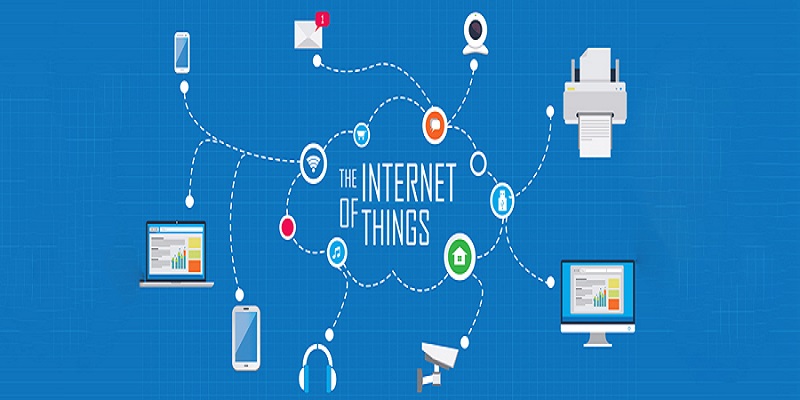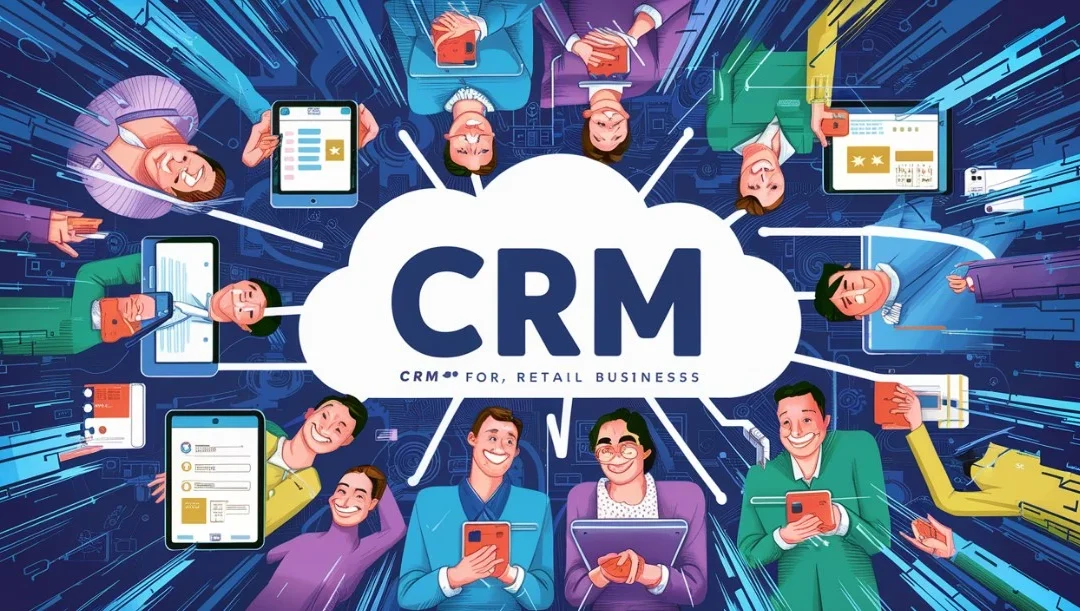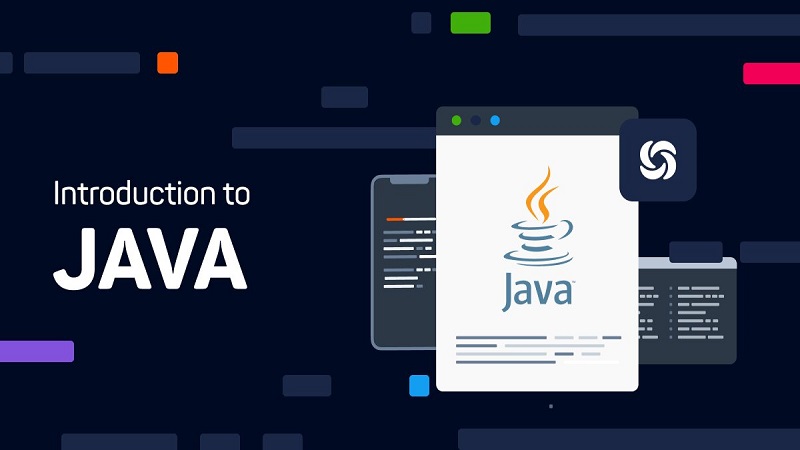What is a Monolith Application?
A monolith application is a software structure where all the components and features of the application are tightly integrated into a single codebase and operate as a single unit. In a monolith architecture, the user interface, business logic, database operations, and other components are all part of a unified code structure.
Monolith applications are often contrasted with Microservices architectures, where an application is broken down into smaller, loosely coupled services that can be developed, deployed, and scaled independently.
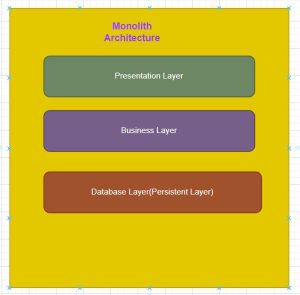
What are the Disadvantages of Monolithic Applications?
While monolithic applications can be suitable for certain projects, especially in the early stages, their disadvantages often become apparent as the application and the organization grow. The rigidity, complexity, and scale challenges associated with monoliths have prompted many organizations to adopt more modular and distributed approaches.
-
Scalability Challenges
In a monolithic architecture, scaling typically means replicating the entire application on more servers or increasing the capacity of existing ones. This can be inefficient, as different components may have varying resource requirements. For instance, the component handling user authentication might be under a heavier load than the one generating reports, but in a monolith, you can’t scale them independently. This all-or-nothing approach can lead to over-provisioning and higher costs.
-
Increased Complexity Over Time
As an application grows in size and functionality, its codebase becomes more complex and unwieldy. This complexity can lead to longer onboarding times for new team members and can make the application more difficult to understand and maintain. The risk of introducing bugs increases as developers may inadvertently affect parts of the system they did not intend to change.
-
Slower Development and Deployment Cycles
In a monolithic application, even small code changes can necessitate rebuilding and redeploying the entire application. This can slow down development cycles, as testing and deployment become more cumbersome. The situation is exacerbated in teams that practice continuous deployment, where the goal is to push changes to production frequently.
-
Difficulties in Adopting New Technologies
Monolithic applications tend to be built on a single technology stack, which can make it difficult to take advantage of new technologies or frameworks that emerge over time. The cost of implementing a new technology in a monolith can be prohibitive, as it could require rewriting large portions of the application.
-
Reliability and Fault Isolation Issues
In a monolithic system, a failure in any component can potentially take down the entire application. There’s no isolation, so a memory leak or an unhandled exception in one area can impact all users. This contrasts with Microservices, where an issue in one service can often be contained without affecting the rest of the application.
-
Hindered Development Velocity
Large, complex monolithic codebases can slow down development velocity. Developers may need to navigate through vast amounts of code to make changes, ensuring that they don’t introduce side effects. The fear of breaking something inadvertently can lead to a more cautious approach to innovation, which can stifle creativity and slow down the introduction of new features.
-
Collaboration and Coordination Overhead
In a monolithic architecture, there’s often a tight coupling between various parts of the application. This means that changes in one area may require coordination with developers working on other parts of the system. As the number of developers or teams working on the application increases, so does the overhead of communication and coordination. This can lead to bottlenecks, where the progress of one team is dependent on the deliverables of another.
-
Difficult Refactoring and Modernization
Refactoring a monolithic application can be a daunting task due to the interdependencies within the codebase. Significant changes might involve a lot of risk and require extensive testing across the entire application. As a result, monolithic applications can become resistant to change, making it difficult to modernize the technology stack or improve the system’s architecture.
-
Single Point of Failure
A monolithic application frequently represents a singular vulnerability point. If the application crashes or encounters a critical issue, the entire system becomes unavailable to users. This can lead to significant downtime and potential loss of business.
What are the Key Benefits of Switching to a Microservices Architecture?
Key benefits of switching to a Microservices architecture with a real-time example:
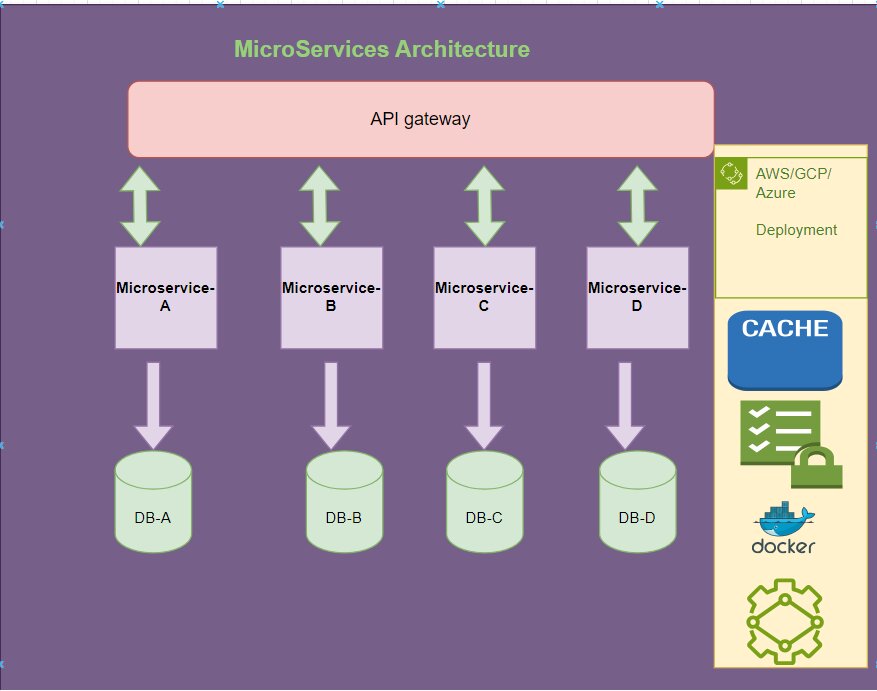
-
Flexibility and Agility
Microservices enable teams to work on different services independently, leading to faster development cycles and improved agility. Teams can iterate on services and deploy changes more quickly without affecting the entire application. For instance, in a video streaming platform, the recommendation service can be updated frequently without disrupting the video playback service.
-
Technology Heterogeneity
With Microservices, teams can choose the most suitable technology stack for each service based on its specific requirements. This allows for greater flexibility and the ability to leverage the strengths of different technologies. For example, in an e-learning platform, the live video streaming services may be implemented using a different technology stack than the quiz engine service.
-
Scalability
Microservices allow for horizontal scaling of individual services based on specific needs. This means that different components of an application can be scaled independently, providing better resource utilization and cost efficiency. For example, in a healthcare application, the patient records service can be scaled separately from the appointment scheduling service during peak hours.
-
Easier Maintenance and Testing
Smaller codebases and well-defined boundaries between services make it easier to maintain and test individual components. This can lead to improved overall code quality, easier debugging, and faster resolution of issues. In a retail application, the inventory management service can be updated and tested independently from the order processing service.
-
Resilience
Microservices architecture promotes fault isolation, meaning that failures in one service do not cascade to other parts of the system. Services can be designed to handle failures gracefully, improving the overall resilience of the application. In a banking application, if the transaction service experiences an issue, customers can still access their account information through the account balance service.
-
Improved DevOps Practices
Microservices architecture aligns well with DevOps principles and practices, such as continuous integration and continuous deployment (CI/CD). Teams can deploy changes to individual services independently, facilitating faster and more frequent releases. In a travel booking application, the flight search service can be updated and deployed separately from the hotel booking service.
Real-time Example: Microservices in a Travel Booking System
Let’s consider a travel booking platform like Expedia that leverages a Microservices architecture to provide various benefits:
- The flight booking service can scale independently from the car rental service, allowing the platform to handle fluctuations in demand during holiday seasons or special events.
- The development team can work on enhancing the hotel search service without impacting the vacation package booking service, enabling faster feature delivery.
- If the payment processing service encounters an issue, customers can still search for flights and hotels, ensuring a seamless user experience.
- Expedia can utilize different technologies for different services based on their unique requirements. For instance, the review and rating service may utilize a different technology stack than the booking confirmation service.
- Each service can be independently tested and maintained, making it easier to identify and resolve issues. Updates and maintenance can be performed on individual services without disrupting the entire booking platform.
- Expedia can deploy changes to different services independently, enabling faster updates and enhancements to the platform. For example, the travel insurance service can be updated without affecting the flight status tracking service.
Fundamentals of Microservices Architecture
Microservice architecture is a method of software application development services systems that are divided into small, independently deployable services. Each service is delimited by a specific business function and interacts with other services through clearly defined APIs. This approach contrasts with traditional monolithic architecture, where all components of the application are tightly integrated and deployed together. The main goal of Microservices is to increase agility, scalability, and maintainability of software applications.
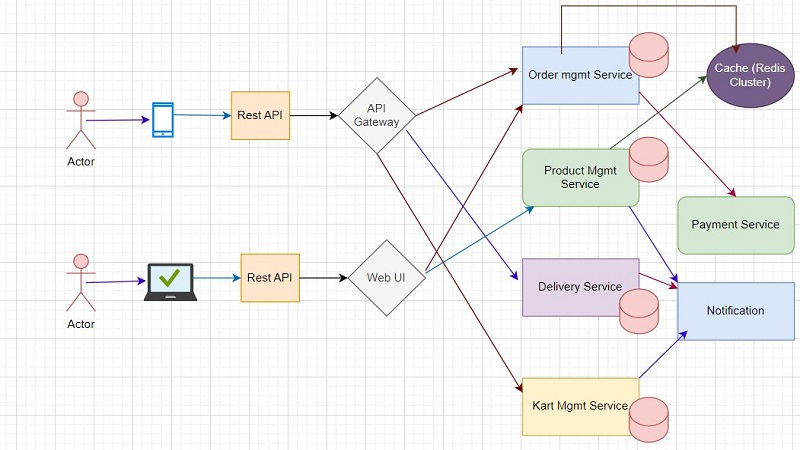
Key Characteristics of Microservice Architecture:
Decomposition
Involves breaking down applications into smaller components known as Microservices, with each Microservice assigned responsibility for a distinct business functionality.
Independence
Each Microservice is developed, deployed, and managed independently. This means that changes to one service can be made without affecting others, facilitating quicker updates and maintenance.
Decentralization
Microservices embrace decentralized data management and decentralized governance. Each service manages its data, and decisions regarding technology and implementation are made at the service level rather than being centrally dictated.
Resilience
The failure of a single service does not necessarily bring down the whole system. Microservices are designed to cope with failures through patterns like circuit breakers and bulkheads.
Technology Diversity
Teams can choose the best technology stack for their specific requirements of a service. This heterogeneity allows for innovation and optimization of resources.
Key considerations while developing basic Microservices:
Define Your Services
Start by identifying the business capabilities of your application. Each capability should map to a single Microservice. Aim for services that are small, loosely coupled, and can be developed and deployed independently.
Choose Your Technology Stack
Since Microservices allow for technology diversity, select the programming languages, databases, and tools that best fit each service’s needs. Common technologies include Docker for containerization, Kubernetes for orchestration, and a variety of programming languages and database technologies.
Design Your Microservices Architecture
Plan how your services will communicate with each other. Common patterns include using HTTP/REST with JSON or binary protocols like gRPC. Also, consider implementing API Gateways for a single entry point to your Microservices.
Handle Data Management
Each Microservice should own its domain data and logic. Decide on the data storage (SQL, NoSQL, etc.) based on the service’s needs.
Implement Service Discovery
This enables services to find and communicate with each other in a dynamic environment. Solutions like Eureka, Consul, and Kubernetes services are commonly used.
Ensure Fault Isolation and Tolerance
Implement strategies like timeouts, retries with exponential backoff, and circuit breakers to make your system resilient to failures.
Develop and Test
Develop each Microservice independently using the chosen technologies. Automated testing at various levels (unit, integration, contract) ensures reliability.
Deploy and Monitor
Use CI/CD pipelines for automated deployment. Monitor your Microservices with tools like Prometheus, Grafana, and ELK stack to ensure they perform well and quickly identify issues.
Key considerations when Migrate from Monolith to Microservices Architecture
Implementing Microservices involves a series of steps designed to structure an application as a collection of loosely coupled services, which improves modularity and allows for easier scaling and maintenance. Here’s a concise guide to the basic steps involved when migrate from monolith to Microservices architecture:
Define Your Business Goals
Clearly understanding the problems you want to solve with Microservices or the specific benefits you aim to achieve (e.g., scalability, faster deployments) is crucial for guiding your implementation strategy.
Identify The Services
Break down the application into individual, loosely coupled services. Each service should have a single responsibility and focus on a specific business function or domain.
Choose Your Technology Stack
Decide on the technologies for developing, deploying, and managing your Microservices. This includes programming languages, databases, messaging protocols, and containerization tools (like Docker, and Kubernetes).
Design Your Microservices Architecture
Plan how your Microservices will communicate with each other. This typically involves using APIs and choosing between synchronous (HTTP/REST) and asynchronous (messaging queues) communication.
Implement Service Discovery
This allows services to dynamically discover and communicate with each other. Options include using a service registry or DNS-based discovery.
Implement API Gateways
An API gateway acts as a single entry point for all clients. It routes requests to the appropriate Microservice and aggregates responses from multiple services.
Ensure Database Separation
Each Microservice should own its database to ensure loose coupling. Decide on the type of database each service needs based on its requirements.
Integrate Security Practices
Implement security at every layer of your architecture, including authentication, authorization, and securing communications between services.
Set Up CI/CD Pipelines
Continuous Integration and Continuous Deployment (CI/CD) pipelines are crucial for automating the testing, building, and deployment processes, allowing for frequent and reliable updates.
Implement Monitoring and Logging
Use tools to monitor the health of your services, track dependencies, and collect logs. This information is critical for troubleshooting and performance tuning.
Test Your Microservices
Implement a testing strategy that includes unit testing, integration testing, and end-to-end testing to ensure reliability and performance.
Plan for Scalability
Consider how your services will scale. This includes strategies for handling load balancing, caching, and database sharing.
Iterate and Optimize
Microservices implementation is an ongoing process. Continuously collect feedback, monitor performance, and adjust your architecture and practices as needed to improve.
Transforming Monolith Application to a Microservices Architecture
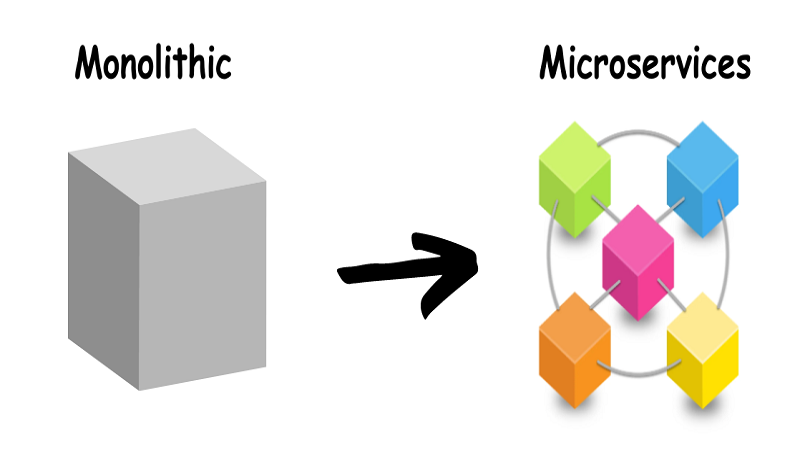
The transformation of monolith application to microservices architecture is usually driven by the need for better scalability, agility, and maintainability. Below is a trending approach to achieve this:
1) Understand and Document the Monolith
Before starting the conversion, you need a deep understanding of your monolith application. This includes:
-
Codebase Inspection
Review the code to understand its components and functionalities.
-
Dependency Mapping
Document how different parts of the application interact with each other.
-
Data Schema Analysis
Analyse your database schema and how data flows throughout the application.
-
Identifying Business Capabilities
Identify the core business functionalities your application provides.
2) Define Microservices Boundaries
Based on the understanding of the application, start defining potential of Microservices development Services. This can be done by:
-
Domain-Driven Design (DDD)
Use DDD to align Microservices with business capabilities.
-
Bounded Contexts
Identify logically isolated areas of your application that can operate as independent services.
-
Service Granularity
Determine the right size for your services, aiming for a balance between too many tiny services and too few large services.
3) Establish a Microservices Infrastructure
Before you start breaking down the monolith, establish the infrastructure that will support Microservices. This involves:
-
Selecting Technology Stack
Choose appropriate technologies for developing, deploying, and running Microservices.
-
Setting Up DevOps
Implement continuous integration and continuous delivery (CI/CD) pipelines for automated testing and deployment.
-
Implement Service Discovery
Set up mechanisms for services to discover and communicate with each other.
-
Define Monitoring and Logging
Implement monitoring and logging to track the health and performance of your services.
4) Incrementally Break Down The Monolith
Start breaking down the monolith into Microservices gradually, following the Strangler Fig Pattern:
-
Identify a Module to Extract
Start with a module or functionality that is relatively independent and has a clear boundary.
-
Create the Microservice
Develop the identified functionality as a standalone Microservice.
-
Redirect Traffic
Use APIs or events to redirect the relevant requests from the monolith to the new Microservice.
-
Iterate
Repeat the process for other functionalities until the monolith is fully decomposed.
5) Refactor for Microservices
As you extract services, you might need to refactor them to ensure they are truly independent. This includes:
-
Decomposing the Database
Move from a monolithic database to separate databases for each Microservice, ensuring data sovereignty.
-
Implementing API Gateways
Use API gateways to manage requests to various Microservices.
-
Handling Distributed Data
Address challenges related to distributed data management, such as eventual consistency.
6) Optimizing and Scaling
With your Microservices in place, focus on optimization and scaling:
-
Performance Tuning
Optimize the performance of each service based on its specific workload.
-
Scalability Enhancements
Leverage the scalability advantages of Microservices by using container orchestration tools like Kubernetes
Migrating Complex OMS from Monolith to Microservices
Migrating a complex legacy OMS (Order Management System) from a monolith Spring MVC architecture to a Microservices-based architecture using Spring Boot involves several detailed steps. To provide clarity, let’s use an example of a hypothetical legacy OMS built with Spring MVC, handling functionalities like order processing, inventory management, and customer management.
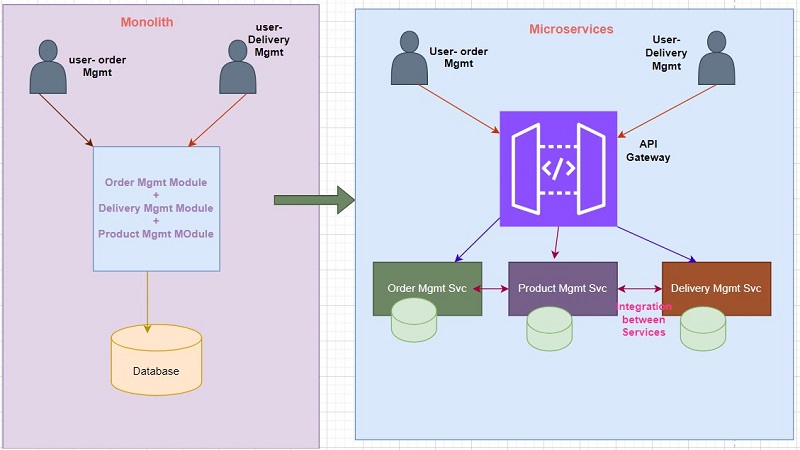
1) Analysis and Planning
-
Understand the Existing System
Thoroughly analyze the existing monolithic architecture, including database schemas, codebase, dependencies, and third-party integrations.
-
Define Microservices Architecture
Plan the breakup of the monolithic system into Microservices. For the OMS, potential services could be Order Service, Inventory Service, and Customer Service.
-
Assess Dependencies
Identify and document inter-service dependencies to ensure that the decoupled services interact seamlessly.
-
Plan Database Migration
Consider how you’ll handle the database – whether moving to a Microservices-friendly database model like database-per-service or sticking with a shared database while ensuring database isolation per service.
-
Identify Tools and Technologies
Decide on the tools and technologies (e.g., Spring Boot, Docker, Kubernetes) to be used in the new architecture.
2) Setup Development Environment
-
Project Structure
Create separate project setups for each Microservice using Spring Boot, considering the defined Microservices architecture.
-
Dependencies
Add necessary Spring Boot starters and dependencies (e.g., Spring Web, Spring Data) to each Microservices project.
-
Version Control
Set up a version control system with separate repositories or branches for each Microservice.
3) Migrate and Refactor
-
Incremental Migration
Start migrating one module at a time to its respective Microservice. For instance, migrate the Order module first.
-
Business Logic
Refactor the business logic from the monolithic architecture to fit the Microservice. Loosely couple the services while ensuring they meet the defined functionalities.
-
Database Migration and Refactor
Depending on the chosen database strategy, migrate the schemas and refactor queries to adapt to the new model.
-
API Development
Develop RESTful APIs for Microservices interaction, ensuring they’re lightweight and adhere to best practices.
4) Implement Microservices Patterns
-
API Gateway
Implement an API Gateway to route requests to appropriate Microservices, manage API versioning, and handle authentication.
-
Service Discovery
Utilize Spring Cloud Netflix Eureka or a similar service discovery mechanism to manage service instances.
-
Circuit Breaker
Integrate a circuit breaker pattern, like Hystrix, to prevent failures in one service from affecting others.
-
Config Server
Use Spring Cloud Config Server for centralized configuration management across all Microservices.
5) Microservices Testing
-
Unit Testing
Write unit tests for each Microservice, focusing on business logic.
-
Integration Testing
Test the interactions between Microservices, including API communications and data exchanges.
-
End-to-End Testing
Test the entire system flow to ensure the migrated OMS functions as expected in the Microservices architecture.
6) Deployment
-
Containerization
Dockerize each Microservice for easier deployment and scaling.
-
Orchestration
Utilize Kubernetes for managing containers, ensuring high availability and scalability of services.
-
CI/CD Pipeline
Set up a Continuous Integration/Continuous Deployment pipeline using tools like Jenkins, GitLab CI, or GitHub Actions for automated testing and deployment.
7) Monitoring and Scaling
-
Monitoring
Implement monitoring tools (e.g., Prometheus, Grafana) to monitor the health and performance of Microservices.
-
Logging
Utilize centralized logging with ELK Stack or similar to aggregate logs for easier troubleshooting.
-
Auto-Scaling
Leverage Kubernetes’ auto-scaling capabilities to automatically scale services based on load.
This approach to migrating a legacy OMS to a Microservices architecture requires careful planning, implementation, testing, and maintenance but can significantly increase scalability, maintainability, and deployment efficiency.
Detailed Example for Migrating Legacy OMS to a Microservices Architecture
1. Order Service
- Manages orders, including creation, retrieval, modification, and cancellation.
- Communicates with other services such as Customer Service and Product Service.
- Publishes events for significant order state changes.
2. Customer Service
- Handles customer-related operations such as creation, retrieval, and update.
- Stores customer information and provides endpoints for CRUD operations.
3. Product Service
- Manages products, including inventory tracking and availability.
- Provides endpoints for CRUD operations on products.
4. Payment Service
- Deals with payment processing and integration with payment gateways.
- Receives payment requests from the Order Service and communicates with external payment APIs.
5. Notification Service
- Sends notifications to customers regarding order status updates.
- Listens for events published by the Order Service and triggers appropriate notifications.
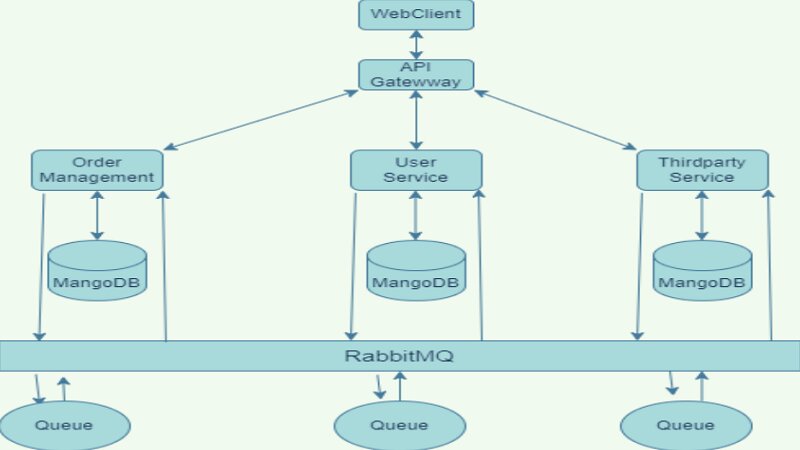
Detailed Implementation of E-Commerce Order Management App
For simplified real-time order management, each Microservice would expose APIs to perform various operations related to its domain. Below are the suggested APIs for each Microservice:
RESTful APIs
1.1 Order Service:
- `POST /orders`: Create a new order.
- `GET /orders/{orderId}`: Retrieve details of a specific order.
- `PUT /orders/{orderId}`: Update an existing order.
- `DELETE /orders/{orderId}`: Cancel an order.
- `GET /orders/customer/{customerId}`: Retrieve orders for a specific customer.
1.2 Customer Service:
- `POST /customers`: Create a new customer.
- `GET /customers/{customerId}`: Retrieve details of a specific customer.
- `PUT /customers/{customerId}`: Update an existing customer.
- `DELETE /customers/{customerId}`: Delete a customer.
- `GET /customers/{customerId}/orders`: Retrieve orders associated with a specific customer.
1.3 Product Service:
- `POST /products`: Create a new product.
- `GET /products/{productId}`: Retrieve details of a specific product.
- `PUT /products/{productId}`: Update an existing product.
- `DELETE /products/{productId}`: Delete a product.
- `GET /products`: Fetches a list of products (all products).
- `GET /products/inventory/{productId}`: Retrieve inventory details for a specific product.
1.4 Payment Service:
- `POST /payments`: Initiate a payment transaction.
- `GET /payments/{paymentId}`: Retrieve details of a specific payment transaction.
- `PUT /payments/{paymentId}`: Update an existing payment transaction (e.g., for handling refunds).
- `DELETE /payments/{paymentId}`: Cancel a payment transaction.
Implementing order processing system with Microservices
Let’s use a simplified order processing system as an example, which is divided into three Microservices: Order Processing, Inventory Management, and Payment Processing.
Order Processing Microservice
-
Responsibility
Handles customer orders, and communicates with Inventory and Payment Microservices to process orders.
-
Endpoints
`/createOrder`, `/cancelOrder`
-
Technology
Spring Boot for REST API, RabbitMQ for async communication with other services.
Inventory Management Microservice
-
Responsibility
Manages product stock levels, and updates inventory after an order is processed.
-
Endpoints
`/checkStock`, `/updateStock`
-
Technology
Spring Boot, MongoDB for storage.
Payment Processing Microservice
-
Responsibility
Handles payment authorizations and transactions.
-
Endpoints
`/authorizePayment`, `/processPayment`
-
Technology
Spring Boot, external payment gateway integration.
Choose Your Database: SQL or No-SQL
The choice between a SQL (relational) database and a NoSQL (document-oriented) database depends on various factors, including the specific requirements and characteristics of your application. Let’s consider how each type of database might fit with the given scenario:
SQL Database
-
Consistency
SQL databases offer strong consistency guarantees, making them suitable for applications where data integrity and consistency are paramount, such as financial systems or applications with complex transactional requirements.
-
Structured Data
If your data has a well-defined schema and relationships between entities (e.g., orders, customers, and products), an SQL database may be a good fit. SQL databases excel at handling structured data and enforcing relationships through foreign key constraints.
-
ACID Transactions
SQL databases typically support ACID (Atomicity, Consistency, Isolation, Durability) transactions, ensuring that transactions are processed reliably and consistently, which is crucial for maintaining data integrity in transactional systems.
NoSQL Database
-
Flexibility
Document-oriented NoSQL databases, such as MongoDB, offer schema flexibility, allowing you to store heterogeneous data structures within documents. This flexibility can be beneficial for applications with evolving schemas or where the data model is subject to frequent changes.
-
Scalability
NoSQL databases are often designed for horizontal scalability, making them suitable for handling large volumes of data and high throughput. If your application needs to scale horizontally to accommodate increasing loads, a document-oriented NoSQL database may be a good choice.
-
Developer Productivity
NoSQL databases are often favored by developers due to their ease of use and flexibility. They allow developers to work with data more natural way, without the constraints of a fixed schema or complex joins.
Considerations
-
Consistency Vs Scalability
SQL databases prioritize strong consistency, while NoSQL databases often prioritize scalability and partition tolerance. Consider your application’s requirements regarding consistency and scalability to make the appropriate choice.
-
Data Model Complexity
If your application’s data model is relatively simple and well-defined, an SQL database may provide sufficient support. However, if your data model is complex or subject to frequent changes, a document-oriented NoSQL database might be more suitable.
Order Service Database Design
`Order` Table:
- `order_id` (Primary Key): Unique identifier for the order.
- `customer_id` (Foreign Key): References the customer who placed the order.
- `order_date`: Date and time when the order was created.
- Other relevant fields such as `total_price`, `status`, etc.
`Order_Item` Table:
- `order_item_id` (Primary Key): Unique identifier for each order item.
- `order_id` (Foreign Key): References the order to which this item belongs.
- `product_id` (Foreign Key): References the product being ordered.
- `quantity`: Quantity of the item/product ordered.
- `unit_price`: Price per unit of the product.
`Payment` Table:
- `payment_id` (Primary Key): Unique identifier for the payment transaction.
- `order_id` (Foreign Key): References the order for which the payment was made.
- `payment_date`: Date and time when the payment was processed.
- `amount`: Amount paid for the order.
- `payment_status`: Status of the payment (e.g., pending, completed, failed).
Customer Service Database Design
`Customer` Table:
- `customer_id` (Primary Key): Unique identifier for the customer.
- `name`: Customer’s name.
- `email`: Customer’s email address.
- Other relevant fields such as `address`, `phone_number`, etc.
Product Service Database Design
`Product` Table:
- `product_id` (Primary Key): Unique for the product/item.
- `name`: Name of the product.
- `description`: Description of the product.
- `price`: Price of the product.
- Other relevant fields such as `category`, `quantity_available`, etc.
Payment Service Database Design
`Payment` Table (This could be separate from the Order Service database if needed):
- `payment_id` (Primary Key): Unique identifier for the payment transaction.
- `order_id` (Foreign Key): References the order for which the payment was made.
- `payment_date`: Date and time when the payment was processed.
- `amount`: Amount paid for the order.
- `payment_status`: Status of the payment (e.g., pending, completed, failed).
Notification Service Database Design
This service may not require a database if notifications are sent immediately upon receiving events from other services. However, if persistence is needed for tracking notifications or logs, a simple table with fields like `notification_id`, `customer_id`, `message`, `timestamp`, etc., could be used.
Event-Driven Communication
- Use Apache Kafka or RabbitMQ for event-driven communication between Microservices.
- Define events such as OrderCreated, OrderUpdated, OrderCancelled, etc., and publish these events to Kafka topics.
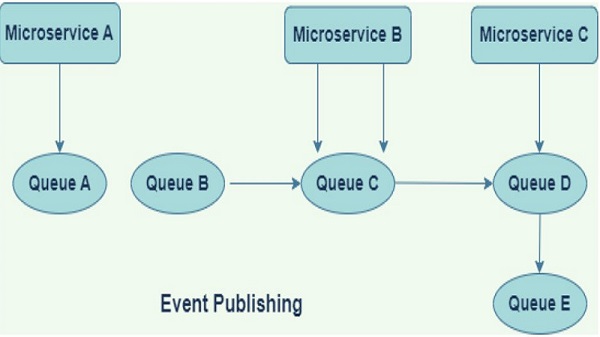
Implementation using Kafka for Order Management Processing
1) Define Events
Identify the significant events in your system, such as orders created, orders updated, orders canceled, etc. Each event should contain relevant information about the event payload.
2) Producers
Within each Microservice, implement event producers to publish events to Kafka topics when certain actions occur. For example, when an order is created in the Order Service, it publishes an “OrderCreated” event to a Kafka topic.
3) Kafka Topics
Define Kafka topics for each type of event. For example, you could have topics like “OrderCreated”, “OrderUpdated”, “OrderCancelled”, etc.
4) Consumers
Implement event consumers in other Microservices to subscribe to the relevant Kafka topics and process the events. For instance, the Payment Service might subscribe to the “OrderCreated” topic to initiate payment processing when a new order is created.
5) Event Processing
Upon receiving an event, each consumer processes it according to its business logic. For example, upon receiving an “OrderCreated” event, the Payment Service might initiate a payment transaction for the corresponding order.
6) Error Handling
Implement error handling mechanisms to deal with scenarios such as event processing failures or retries.
7) Caching
In a complex Order Management System (OMS), caching plays a crucial role in improving system performance and enhancing user experience by reducing database load and ensuring faster data retrieval. Let’s discuss a scenario where caching is particularly beneficial in such a system, followed by how to implement Redis Cache in Spring Boot for that scenario.
Scenario: Product Catalog Data Caching
Caching Requirement
Caching the product catalog data can significantly reduce database calls for frequently accessed, read-heavy, and rarely modified data. When a product detail is requested, the system can first check the cache. If the information is available (cache hit), it is served directly from the cache, drastically reducing response time. If the information is not in the cache (cache miss), it is fetched from the database, and the cache is updated for future requests.
Application & API Gateway Security
- Implement OAuth2 authentication and authorization using Spring Security and Spring Cloud Security.
- Secure communication between Microservices using HTTPS and JWT tokens.
- For a complex Order Management System using Spring Boot, implementing robust application security is vital. Below is an example outlining key security measures, including securing REST APIs, using HTTPS, implementing authentication and authorization, and securing sensitive information.
- Customize security configurations by extending `WebSecurityConfigurerAdapter`
- For securing sensitive configuration data (like database passwords, JWT secret keys, etc.), Spring Boot supports encryption via the Spring Cloud Config Server and the Java Cryptography Extension (JCE). Third-party libraries like Jasypt can also be used for encrypting property values directly within the application.
- Implement Authorization: Spring Security allows configuring method level security using annotations like `@PreAuthorize`. For example, to restrict access to a method that only ADMIN users can invoke:
- Additionally, it can manage cross-cutting concerns such as authentication, SSL termination, and rate limiting, and rate limiting. Here’s how you could implement an API Gateway using Spring Cloud Gateway, which is a part of the broader Spring ecosystem and integrates well with Spring Boot Microservices.
- Integrating Spring Security to manage authentication and authorization is important for securing your API Gateway.
How to Implement Rate-Limiting and Other Cross-Cutting Concerns
Leverage Spring Cloud Gateway features or integrate with third-party libraries to implement rate-limiting, monitoring, and more.
Configure Rate Limiting
Use the Redis rate limiter or integrate with a third-party library for this purpose. Custom filters can also be implemented if specific logic is needed.
Monitoring and Tracing
Integrate with Spring Cloud Sleuth, Zipkin, or other observability tools to enable tracing and monitoring of requests passing through the gateway.
Monitoring and Logging
- Integrate Spring Boot Actuator for monitoring metrics and health checks.
- Use centralized logging solutions like ELK stack or Prometheus and Grafana for monitoring and log aggregation.
- Implementing application metrics in a Spring Boot-based Order Management System can significantly enhance the monitoring and managing performance of the application. Spring Boot Actuator, together with Micrometer, provides a rich toolbox for gathering and exporting metrics about your application’s behavior and performance. Here’s a simple guide to adding basic metrics to your project:
- Inject the `OrderMetrics` component where you process orders, and increment the counter each time an order is processed.
Deployment
Containerize each Microservice using Docker & Kubernetes:
- Use Kubernetes or Docker Swarm for container orchestration and deployment.
- Implement continuous deployment pipelines using Jenkins or GitLab CI/CD.
- For an Order Management System (OMS) project, implementing Continuous Integration/Continuous Deployment (CI/CD) processes and deploying to a cluster environment such as Kubernetes can significantly streamline development workflows and enhance deployment efficiency. Here’s how you can approach this
- Implement CI/CD and deploying to a Kubernetes cluster will help automate your OMS deployment process, enabling more frequent and reliable deliveries.
- Utilize Kubernetes Horizontal Pod Autoscaler (HPA) to automatically scale your Microservices based on CPU or memory usage.
- Deploy your Order Management Microservices to a Kubernetes cluster. Kubernetes provides high availability, scalability, and efficient resource utilization.
- Use a managed Kubernetes service like AWS EKS, Google GKE, or Azure AKS for ease of setup and management.
- Define your Kubernetes manifests or Helm charts for each Microservice, specifying necessary resources, services, and ingress controllers for exposing your Microservices.
Documentation Swagger Implementation
- Implementing Swagger in a Spring Boot application, especially for an Order Management project, enhances the documentation, making it interactive and easier to understand for developers and API consumers.
- Swagger provides a UI to explore all APIs, understand their functionalities, and even execute them directly from the browser.
- After integrating Swagger into your Spring Boot application, you can access the Swagger UI to visualize and interact with your project’s RESTful web services.
- you might have endpoints for creating orders, updating orders, fetching orders by ID, listing all orders, and deleting orders.
- Integrating Swagger with Spring Boot in your Order Management project will significantly improve your API’s documentation and testing capabilities, making development and consumption more straightforward.
Frequently Asked Questions
1) How to get the benefits of switching to Microservices Architecture?
Ans: Improved Scalability, Modularity and Maintainability, Technology Diversity, Resilience, and Enhanced DevOps Practices. Ownership of specific services thereby fostering a sense of autonomy and accountability. Please refer to this blog for detailed understanding.
2) How to migrate from a monolith to a Microservice Architecture?
Ans: Identify and Decompose Services, Design Service Interfaces, Refactor and Implement Microservices, Establish Integration and messaging queues and Orchestration by implementing API gateways, service registries, and distributed tracing. Gradually roll out the Microservices to production environments, beginning with less essential services and transitioning to more critical components over time.
3) What are the key considerations for transforming to Microservices?
Ans: Modularization by creating multiple services considering the application’s functionality, Data Management with data replication and synchronization mechanisms, Inter-Service Communication between Microservices, and Operational Considerations for implementing DevOps practices.

